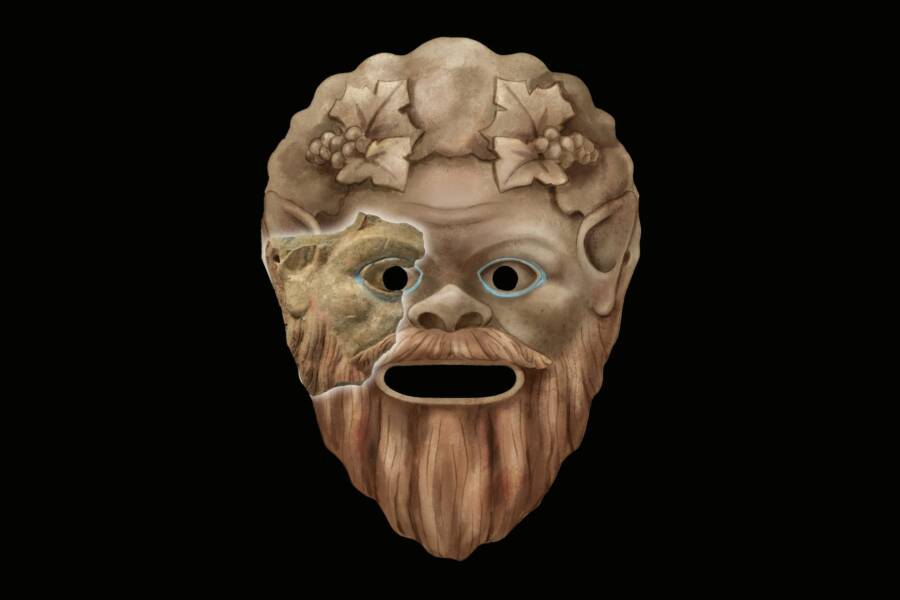Archaeologists In Russia Just Unearthed A 2,200-Year-Old Piece Of A Greek Satyr Mask
Ann BelyaninaAn artists recreation of what the full satyr mask wouldve looked like 2,200 years ago.Archaeologists have found a 2,200-year-old theatrical mask while excavating the ancient Greek city of Phanagoria on Russias Taman Peninsula. This mask provides further evidence of the classical theater that once stood in the city, while also revealing other insights into cultural and religious life in the area.Though this terracotta mask dates back to the second century B.C.E., it still contains visible remains of painted flourishes from when it was used onstage during antiquity. Indeed, due to its size and shape, researchers believe the mask to be a genuine theater prop, rather than an ornament or other decoration of some kind.Whats more, the mask is just one of the finds made during excavations at Phanagoria.The Fragment Of An Ancient Greek Satyr Mask Uncovered At PhanagoriaAnn BelyaninaThe fragment of the satyr mask recently uncovered by archaeologists in Phanagoria.This classical theater mask is about 12 inches long and depicts a satyr, an ancient Greek mythological creature with the body of a human and the horns, tail, and feet of a goat. According to a statement from the Volnoe Delo Foundation, the size of the mask, combined with the large cutouts for the eyes and mouth, indicate that it was a legitimate theatrical prop.Like many other Greek theatrical masks, the artifact has exaggerated features, namely its cheekbones, bushy beard, and large ear. It also contains the visible remains of some painted details, including a blue outline around the eye and red facial hair.The satyr is easily recognizable on a fragment of a terracotta mask by his exaggerated facial features, disheveled hair, and horseshoe-shaped mustache, the Volnoe Delo Foundations statement reads. This is precisely how the goat-legged companions of Dionysus were depicted in performances, celebrating his exploits and accompanying him in processions.Satyrs were indeed often associated with the Greek god Dionysus, god of wine, revelry, and theater. Masks such as this one were used by actors to change roles, with each mask meant to represent that characters core emotional state or role in the story. The satyrs red beard, for instance, would signal to audiences that he had a fiery temper.And in addition to their use in classical theater, masks played an important role within the cult of Dionysus. This cult was particularly popular in Phanagoria, specifically during the rule of Mithridates VI Eupator, who considered the god his patron.The First Tangible Proof Of An Ancient Greek Theater In PhanagoriaPhanagoria MuseumThe Phanagoria excavation site, located near the Black Sea in Russia.The mask was found where researchers believe the ancient theater may have once stood, in the central part of Phanagoria. Before the discovery of this larger theatrical mask, archaeologists had uncovered a number of smaller masks, measuring about just 10 centimeters, that wouldve been used in rituals as opposed to on stage.Similar to the newly-uncovered prop, two of the miniature masks depicted satyrs, and another represented a comic actor. These smaller masks were not used for theatrical performances, but instead served ritualistic purposes as offerings to the gods.The larger satyr mask is the first tangible proof of a functioning theater in the ancient Greek city. Ancient writings had hinted at the existence of a theater along the Northern Black Sea, but until now there hadnt been concrete archaeological evidence.There isnt the slightest doubt that Phanagoria had a theatre, Vladimir Kuznetsov, head of the expedition, told Heritage Daily. We believe it was located on a hill overlooking the sea and modern Kerch the ancient Panticapaeum, capital of the Bosporan Kingdom.Phanagoria was the largest city along the Taman peninsula, founded by Teian colonists around 543 B.C.E. The city primarily functioned as a trading hub for the countries south of the Caucasus mountains.But now, we also have evidence that Phanagoria was once home to a noteworthy arts scene as well. Perhaps more relics from the citys ancient theater will be uncovered as archaeologists continue to peel back the layers of the past.After reading about the ancient Greek theatrical mask uncovered in Phanagoria, see the Roman oil lamp shaped like a Greek theater mask that archaeologists found in the Netherlands. Then, learn about the Roman theater ticket that archaeologists unearthed in Turkey.The post Archaeologists In Russia Just Unearthed A 2,200-Year-Old Piece Of A Greek Satyr Mask appeared first on All That's Interesting.


